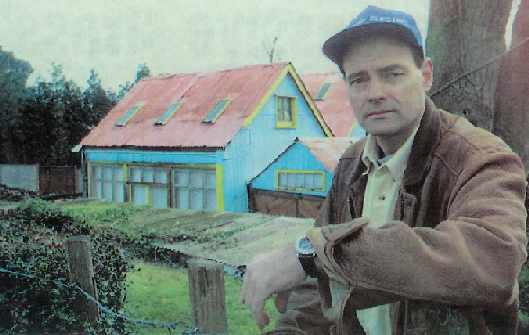|
NEWS:
THE ARGUS - Tuesday, November 30,
1999
|
One
man's fight to have historic power building
recognised
|
| |
|
 |
BELIEF:
Nelson
has been resolute for years that his office, a
historic power generator which used to supply a
whole town, should be listed and made into a
museum, but he has received little support. But
now English Heritage has backed the claim.
|
|
|
by
JOE LEPPER joe.lepper@argus-btn.co.uk
G
e n e r a t i n g i n t e r e s t
TO
LOOK at Nelson's ramshackle and rundown
office you would never guess it was once the most
important building in town. The Inventor,
from Herstmonceux, near Hailsham, has been using
the office to design and build his creations for
the past 18 years.
But
in 1998 he made a startling discovery - beneath
its rusty corrugated tin exterior hides one of
Britain's earliest and last remaining electric
power houses. Back in the Victorian era the
building was the heart of the town, powering the
street lighting and homes for miles around.
Since the discovery he has fought to gain the
recognition the building deserves as a historic
monument.
He
has had bids for listed status turned down, as
well as unsuccessful planning applications to make
it an education center as many did not believe its
past. But now, at last, his dream to
renovate his historic office looks set to come
true.
He
has had its status confirmed by English
Heritage, which added it to its Monument
Protection Programme for protected buildings.
And local councillors have now decided to rethink
their decision on converting the property.
Nelson, 44, who also lives in Herstmonceux, said:
"it's been a struggle to get recognition but
it looks like that has now happened.

GENERATOR
"I
have now also had it confirmed that this is the
only remaining generator
that used to power a whole village."
Built in 1888, the building called the Old Steam
House, was developed by a wealthy landowner in the
village called Baron de Romer for his own use.
It was bought by a local electricity company
during the Edwardian
era and remained in use until the 1930s, when the
national grid took over.
Nelson
said: "Then the technology was all so early
and lights used to flicker in time with the
engine. I try and imagine what that must
have been like for the people then."
For Nelson the discovery is also of great
importance as he mainly designs and builds
electrical creations
At
the side of one of Britain's electrical
masterpieces lies one of the country's latest, as
Nelson is busy building what he hopes will be the
worlds fastest electric
car. He hopes the 22ft long, 400 horse-power
contraption will reach speeds of more than 350mph
and is considering testing it as early as March.
Members of Wealden District Council planning
committee plan to make a decision
on the future of the building next month.
|
A
NOTE FROM OUR EDITOR:
We accept it is difficult for reporters writing articles
of such a complex nature to capture every detail.
In the above article the council concerned issued enforcement
notices between 1982 and 1986, the latter appealed
to the Secretary
of State. The present 'no mans land' planning
blight situation, is preventing conservation works, to
include removing the unsightly tin cladding from the
original timbers. The first planning application
was made in 1988, the last in 1999 (not appealed).
On each of these occasions Wealden District Council
ignored the history attaching to the building, despite
the newspaper report above and umpteen letters and
reports from archaeologists. The last appeal to
the Secretary of State in 1997 elicited a decision
letter also denying the history, which decision was
based on the council's expert witness Ms Chezel Bird's
testimony. The Secretary of State now know she was
wrong - worse still, it appears the council had the
origins of the building on file as early as 1983, but
that this information was not put before the Secretary
of State, but say they cannot undo their decision,
neither did the local authority or the Secretary of
State consult English Heritage, despite PPG16 or
Circular 22 of 1980.
The
council failed to make a decision, but set about trying
to bankrupt their intended victim, in what we presume
was some kind of attempt to whitewash their scurrilous
handling of this matter.
Herstmonceux
Electricity Generating Works Circa. 1900 - 1936
Links:
Introduction
| Instructions
| ISBN
| Batteries
| Boiler
Room | Floor
Plan | Ron
Saunders
Industrial
Revolution
| Lime
Park | Machinery
| Map
| Power
House | Argus
1999
Public
Supply | Roof
Construction | Rural
Supply | Sussex
Express 1913 |
Conclusion
Archaeology
South East
| East
Sussex CC | English
Heritage | SIAS
| Sx
Exp 1999
Memories
of Herstmonceux by Margaret Pollard
|